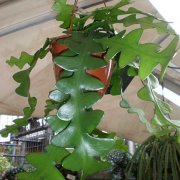Care of the indoor plant Selenicereus anthonyanus or Fishbone cactus |
|
The genus Selenicereus, family Cactaceae, comprises 20 species of epiphytic cacti native to the Caribbean, Central and South America. Some species are: Selenicereus anthonyanus, Selenicereus grandiflorus, Selenicereus hamatus, Selenicereus validus, Selenicereus spinulosus. Common names: Fishbone cactus, Rick rack cactus, Zig-zag cactus. This species is native to southern Mexico. They are slow-growing tropical epiphytic cacti with a climbing or hanging bearing that reach 120 cm (47.24") in length. The long stems are bright green and zigzag shaped. They do not usually bloom outside of their natural environment. Fishbone cactus is used in hanging pots as indoor, patio and terrace and greenhouse plants. In tropical climates it's used as climbing plants to cover walls or as cover plants. Selenicereus anthonyanus prefers exposure to filtered light without direct sunlight. It's a tropical plant that does not resist temperatures below 12 ºC (53.6 ºF). The soil can be a mixture, in equal parts, of leaf mulch and commercial orchid substrate. Transplant in spring every 3-4 years. Water with lime-free water every 5 days in spring and summer, every 7 days in fall and every 10 in winter. It's important that the ambient humidity is at least 50%; spray the plant 2 times a week. Fertilize every month from mid-spring to late summer with mineral fertilizer for cacti and succulents. Zig-zag cactus does not need pruning. If the humidity is low, Selenicereus anthonyanus can be attacked by mealybugs. Rick rack cactus is propagated by stem cuttings set to root in a mini-greenhouse. |
Images of the indoor plant Selenicereus anthonyanus or Fishbone cactus |
Find plants
Selenicereus anthonyanus or Fishbone cactus | Care and Growing
© 2026 FavThemes

